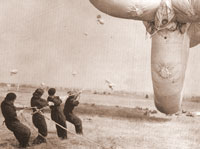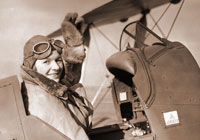 |
||||||||||||||||||||
|
|
||||||||||||||||||||
| One of the hardest, most physically demanding and dangerous jobs to be performed by women in the forces was the operation of balloon sites. This involved raising the heavy barrage balloons that were put up in large numbers to make it difficult for low flying enemy aircraft to approach. In the spring of 1941 women began training to take over this job. Eventually they manned over 1,000 sites throughout Britain. Crews of 10 men were replaced by crews of 16 women, whose job it was to raise and lower the enormous barrage balloons. These balloons held up cables to keep enemy aircraft above a certain height, preventing low-level attacks and making it easier to catch them in anti-aircraft fire.
As with the ATS, women in the WAAF were paid the same wages and had the same status as a man. In other words, they were considered to be equal. |
||||||||||||||||||||
 |
||||||||||||||||||||
| A WAAF team wrestle with one of the huge barrage balloons, raised to keep enemy aircraft at bay. Photo: IWM neg:CH7346 | ||||||||||||||||||||
| The Air Transport Auxiliary (ATA) relied on women to move aircraft to where they were needed. The female pilots would collect new aircraft from the factories and fly them to the airfields as well as moving them between the airfields. The women would fly any sort of plane, from fighters to the big, heavy bombers, but did not take part in air combat. This did not mean that it was a safe job though. During the war 12 ATA pilots were killed in crashes. | ||||||||||||||||||||
 |
||||||||||||||||||||
| Back | ||||||||||||||||||||
|
Photo IWM neg C380
|
||||||||||||||||||||